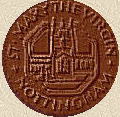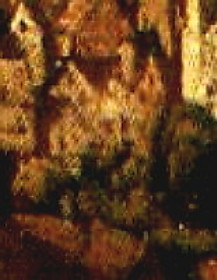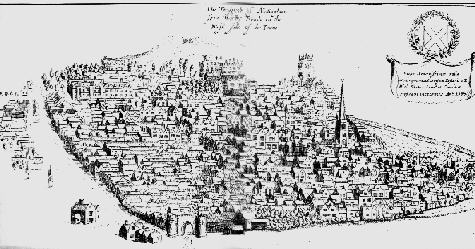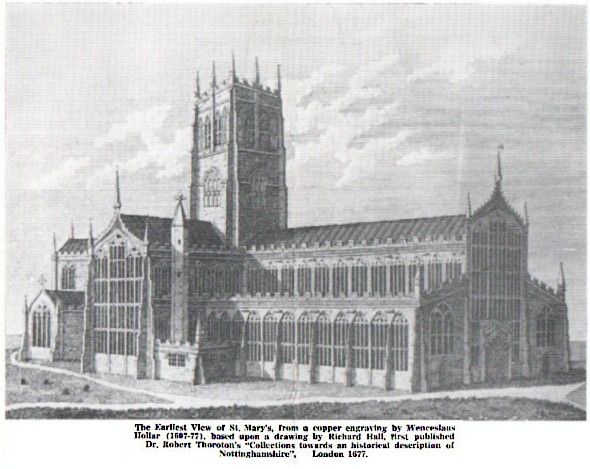 The History of the Parish Church of
St. Mary the Virgin, Nottingham - a Period of Mystery
The History of the Parish Church of
St. Mary the Virgin, Nottingham - a Period of Mystery The History of the Parish Church of
St. Mary the Virgin, Nottingham - a Period of Mystery
The History of the Parish Church of
St. Mary the Virgin, Nottingham - a Period of Mystery
The first record of the seventeenth Century is the burial of "Barnabee Evans Clarke minister of this St maris Buryed" on 10 June, 1601. He, "Barnabe Evans Clark and minester of this church" was also married in St. Mary's, to "Ales Wilford wedow", on 8.5.1597.
In 1603, James VI of Scotland, son of Mary Queen of Scots, succeeded to the throne of England, as James I, and reigned until 1625. He commissioned the Authorized Version or "King James Bible" of 1611.
In the latter year, 1611, the Chancel seems to have been in good repair as the ancient Grammar School was moved there in an attempt to avoid the plague. By way of contradiction there is a report soon after (see the official church website) which had the churchwardens as "under pressure to repair the chancel, damaged by a storm in 1588. The repairs seem to still be outstanding as late as 1635. There are frequent entries in the Archdeaconry Records and include charges against the Vicar. For instance, from the Churchwardens' Presentment Bills for April 21, 1612, we can read - 'St. Maries in Nott. We the Churchwardens, here undernamed, do find that our chancell is in decay, but in whose defaulte we cannot lerne perfitly' ". An entry for 1635, however, records an 'Item wee present that the chancell is out in the defaulte of Thomas Cooke and Richarde Turpyn, farmers of the parsonage, but it is in repayring'.
On 26 July, 1616, was the institution ofOliver Wytherington, MA, as Vicar, the Patron was "William Wetherington, Gent." He died later in the year. His daughter, Anne, had been baptized in St. Mary's on 6.3.1602. On the 4 December, John Tolson, STB, was instituted as Vicar. The Patron now was Sir Robert Pierrepont. Tolson resigned less than ten months later.
So, on 2 October 1617, Ralph Hansby, MA, was instituted as Vicar. Patron "The assignee of Sir Robert Pierrepont". He had been instituted as Rector of Barton-in-Fabis the preceding year, previously being Taxor of the University of Cambridge, being a Fellow of St. John's College, Cambridge. He died 20.11.1635, and was buried the next day in the chancel of St. Mary's. He had married Mrs. Ann Plumtree in St. Mary's on 5.8.1621.
1624-5, finally saw action over the Chancel "wch had beene in grayt decay was set in Repayr by the farmers of tythe by sequestrating of the profitts" and "Stalls on both sides of the Quire were very much decayed". The Parish Register has this as "Item in the year 1625 Mr Hansbee being Vickar the Chancell of St Maryes wch had beene in grayt decay was Set in Repayr by the farmers of tythe by sequestrating of the profitts". The repairs, however, remained far from complete as the reports of its poor state continued until 1635 (see above).
Other needs for repairs, reported in September 1625, were to the Vestry 'our revestrie house and our church storehouse are verie ruinous, namely the revestrie needeth poynting and the storhouse utterly uncovered'. In May the latter had been noted as the 'leades of a little yle upon the north side'. This is the ancient Chantry house and an accompanying note reported that there had been timber 'which was an old frame of the bells, lying in the church, which was carried away by the appointors of Mr. Nixe, now Maior'. The September report by the Vicar had as well - 'the want of a convenient Comunion table, that we have beeing ould and ruinous', (In 1917, the extractor of these reports, F.A. Wadsworth commented that the 'Jacobean table, near the south entrance of the church' might have been provided as the result of this presentment', see below)
Around the same time the Register notes that Mr. Robert Greaves and Mr. Lauranc Walker did set "Certayn sickamor trees & ash trees by the Walk in the Churchyard" and more by the wall.
In 1625, Charles I succeeded his father as king. Continuing his father's belief in "the Divine right of Kings" led him into conflict with Parliament, culminating in the Civil War when he tried to arrest five MPs on a charge of treason in 1642. After defeat in 1648, he was beheaded in January 1649.
Then in 1632, a tree was planted by Richard Breach "a translater of oulde [ware]" in the Churchyard and it "stand hard by his howse end".
On 28 November, 1635, Edmund Laycock (or Lacock), MA, was instituted as Vicar. Patron Robert, Earl of Kingston (now elevated to the peerage). He held the living until 1642/3 when "the Presbyterian regime began". Hood and Godfrey related an epitaph of the same era and recorded by Deering, of George Lacock, Clerk of the Peace, who (in Hood's words) perhaps like his namesake the Vicar - "suffered under the Puritan regime".
The Register of Burials records that on 7.10.1637 the "righte Honorable John Baron Haughton of Haughton & Earl of Clare was buried in the Churche of Sainct Marie in Nottingh Edmund Lacocke bachelor of Divinitie Vicar there Mr Humfrie Greaves and Mr Thomas Widdowson being then Churchwarden [signed] Edmundus Lacock Vicar: ibidem. Humfrey Greaves; Thomas Widdowson". John Holles, first Earl of Clare, had a distinguished military career, including serving against the Spanish Armada, and had been created Baron Holles in 1616 and Earl of Clare in 1634. On the Sunday before his death, before going from prayers at St. Mary's, "he suddenly put his staff upon a particular spot and said ' Here will I be buried'". This spot was in the south transept, where his wife, Anne, was buried alongside him, on 22.12.1651, and also one of his children, Eleanor, buried there on 11.4.1681. Later a large marble monument was erected (see entry for 1665 below).
Humphrey Greaves, who was son of a minister of Notal [Nuttall] was buried in St. Mary's on 31.8.1650.
Also in 1637, there were - monies being raised for "castinge of the greate Bell as allsoe for the present repaire of the decaies in the Topp of the Steeple", and wood was felled in the town coppice for the building of lofts (or galleries) in the church.
In
1641, there was a "Vicar, 2 parish clerks, 2
sextons, 6 constant bellringers". The next year, 1642,
saw the start of the Civil War - the Marriage Register recorded "On
Munday August 22 1642 King Charles set up his Standard at the Castle"
(picture right, which also is perhaps the earliest illustration of today's
church). Godfrey added that it was curious that this was not reported in
any other official records of events in the town. It may indicate the
Royalist sympathies of Edmund Lacock and why he gave up (or was forced to
give up?) the living some time later in the year. After the Battle of
Edgehill in October, the country began to polarize itself and Sir John
Gell occupied Derby on behalf of Parliament and then assisted John
Hutchinson and his political allies to take control of Nottingham. An
uneasy stalemate between local Royalists and Hutchinson's supporters kept
Nottingham's importance to the Parliamentarian cause in check until July
1644, although the latter were able to prevent the King's revenue
collectors from crossing Trent Bridge. The most significant Royalist
offensive on Nottingham took place in January 1644, but the battles led to
the destruction of St. Nicholas's church and some damage to St. Peter's.
Throughout the Castle had strategic importance and this ultimately led to
the Parliamentarians reducing it to rubble in November 1651. John
Hutchinson had been baptized in St. Mary's on 18.9.1615, the elder son of
Thomas and Mary Hutchinson, of Nottingham and Owthorpe, Notts. Apart from
his Parliamentarian exploits as Governor of Nottingham Castle, he was
among the signatories of the death warrant for the execution of Charles I.
After the Restoration he was imprisoned at Sandown Castle in Kent, dying
there on 11.9.1664, and being buried in Owthorpe Church.
 1642-60,
began the Parliamentary Rule and the Commonwealth, of Puritan
government. It is assumed that St. Mary's suffered from losses of brasses
and destruction of coloured glass took place during the latter years. Our
Organs book cites Deering as noting how during the Civil War "a
certain person (then still living) when Churchwarden, sold the
Organ-Pipes, and left the empty case in its place.... at the entrance to
the Quire". The High Altar was not used a table being placed
forward of the chancel step. The Commonwealth, or Guild, Communion
Table, in the north transept was rediscovered as a "book
cupboard" by the south door when Canon Gordon was Vicar
(photograph on right taken in 1957), but see above for the 1625 request
for a Communion Table.
1642-60,
began the Parliamentary Rule and the Commonwealth, of Puritan
government. It is assumed that St. Mary's suffered from losses of brasses
and destruction of coloured glass took place during the latter years. Our
Organs book cites Deering as noting how during the Civil War "a
certain person (then still living) when Churchwarden, sold the
Organ-Pipes, and left the empty case in its place.... at the entrance to
the Quire". The High Altar was not used a table being placed
forward of the chancel step. The Commonwealth, or Guild, Communion
Table, in the north transept was rediscovered as a "book
cupboard" by the south door when Canon Gordon was Vicar
(photograph on right taken in 1957), but see above for the 1625 request
for a Communion Table.
Sometime in 1643, Rev. Nicholas Folkingham became "minister for God's word for this Parish of maries". The baptism of his daughter Anne, in St. Peter's on 1.19.1640, recorded him as Nicholas Folkingham, "Clerk" [i.e. in holy orders]. His burial, on 12.3.1648, is recorded in the Burial Register of St. Mary's as "Mr. Nichollis Faullkingham".
Interior changes began in 1646, when Galleries were paid for by Town Council.
The Baptism Register entry for 27.12.1649, has "Hester the daughter of mr. Jonathan Boole minister of the parish", Godfrey noted also that The Rev. Jonathan Boole was one of the "sequestrators" of Clifton Rectory, Notts., during the "Usurpation", and that he subsequently "conformed".
 In April, 1651, by "the joynt suffrage of the
parishioners" the Revs. John Whitlock and William Reynolds,
Masters of Arts of Emmanuel College , Cambridge, were appointed as
Minister and Lecturer respectively of St. Mary's. Among their supporters
and among the "ruling elders" of the church was "The
right honnble Francis Pierepont". Blackner related how each was
to receive £60 per annum while single and £100 "if they
entered into the marriage state". Whitlock and Reynolds were
lifelong friends. "They lived together, they preached together,
they travelled together; nothing but death could separate them, and that
but for a short season; their friendship was indeed such that they seemed
to have but one soul". Both resided at St. Mary's
Vicarage with their families, the vicarage being built or at
least considerably enlarged that year to accommodate them all. From
Blackner, it seems that it may have been a new building, for which the
parish gave £300 towards the building, the corporation gave the
timber and "the two gentlemen paid the rest of the expense".The
Sandby prospects (of the early 1700s) show the Dutch Gable ends on the
Vicarage (on Short Hill). William and Susannah Reynolds had children
baptized at St. Mary's - John, on 22.7.1654, Susannah (born 13.7.1661) on
19.7.1661. John and Mary Whitlock also had children baptized there - Mary,
on 17.2.1656, John (see later) on 19.4.1661. Francis Pierrepont was the
third son of Robert Pierrepont, Earl of Kingston. After his death in
January 1657, his burial is recorded as being in St. Mary's, but on
18.3.1657, his funeral sermons were preached by Reynolds at St. Mary's and
then by Whitlock at Holme Pierrepont "the Place of his
Interrement".
In April, 1651, by "the joynt suffrage of the
parishioners" the Revs. John Whitlock and William Reynolds,
Masters of Arts of Emmanuel College , Cambridge, were appointed as
Minister and Lecturer respectively of St. Mary's. Among their supporters
and among the "ruling elders" of the church was "The
right honnble Francis Pierepont". Blackner related how each was
to receive £60 per annum while single and £100 "if they
entered into the marriage state". Whitlock and Reynolds were
lifelong friends. "They lived together, they preached together,
they travelled together; nothing but death could separate them, and that
but for a short season; their friendship was indeed such that they seemed
to have but one soul". Both resided at St. Mary's
Vicarage with their families, the vicarage being built or at
least considerably enlarged that year to accommodate them all. From
Blackner, it seems that it may have been a new building, for which the
parish gave £300 towards the building, the corporation gave the
timber and "the two gentlemen paid the rest of the expense".The
Sandby prospects (of the early 1700s) show the Dutch Gable ends on the
Vicarage (on Short Hill). William and Susannah Reynolds had children
baptized at St. Mary's - John, on 22.7.1654, Susannah (born 13.7.1661) on
19.7.1661. John and Mary Whitlock also had children baptized there - Mary,
on 17.2.1656, John (see later) on 19.4.1661. Francis Pierrepont was the
third son of Robert Pierrepont, Earl of Kingston. After his death in
January 1657, his burial is recorded as being in St. Mary's, but on
18.3.1657, his funeral sermons were preached by Reynolds at St. Mary's and
then by Whitlock at Holme Pierrepont "the Place of his
Interrement".
In 1656, the Mayor and company agreed to pay 20s towards the building of a Lofte in the church; subsequently, trees to a value of £12 was "sett oute for the bridges and a lofte" at St. Mary's. Then in 1657-8, The Corporation agreed to pay 30s towards the building of a "Stere-Case" in the church.
In 1660 came The Restoration and accession to the
throne of Charles II, son of Charles I. Parliament remained
puritanical and anti-Catholicism was strong. Following the Restoration
religious revival and condemnation of Puritanism led to the Act of
Uniformity, with the enforcement of the ordination of ministers and the
reissue of the Book of Common Prayer. Mr. John Whitlock and William
Reynolds were among those who felt unable to conform and so was
ejected in 1662. Initially they moved together to Colwick Hall, and were
imprisoned at the Blackmoor's Head Inn in Nottingham for 12 weeks from
September 1663. The passage of the Oxford, or Five Mile Act, forced them
to move more than five miles from their old parish and they moved to
Shirebrook, in Derbyshire, some three miles from Mansfield. Essentially,
they remained there for over 19 years, until October 1687, when they moved
back to Nottingham. Together with the Rev. John Barrett, formerly minister
of St. Peter's, they were associated with the setting up of the new High
Pavement Chapel in 1690.
After Reynolds death on 26.2.1697 (he was buried at St. Mary's on
1.3.1697), Whitlock continued to be active for some eight more years, two
years later he died and was buried in St. Mary's on 4.12.1708. His
tombcover now is close by the pulpit. His son, also Rev. John, was
baptized at St. Mary's (born 11.4.1661, baptized, 19.4.1661), and
succeeded his father as a minister of the High Pavement Chapel, serving
until he died on 16.3.1723, aged 62. In the north transept, also near the
pulpit, is a large blue floorstone (Godfrey noted "removed from
the Chancel") of John II. His son, Nathaniel, also was a Minister
at the High Pavement Chapel from 1727.
On 11 September, 1662, came the institution of the
Rev. George Masterson, MA, as Vicar, on the presentation of Robert
Pierrepont. Masterson was also a Prebendary of Southwell (the title means
a stipendiary of a cathedral, curious as Southwell was not such at that
time). He died 8.9.1686, being buried in St. Mary's the next day. Kathrin,
daughter of George and Rebeccka, his wife, was baptized at St. Mary's on
23.4.1663. 
In about 1665, the erection took place of the Earls of Clare Tomb, this was after the death of the second Earl, on 2.1.1665; it was removed in 1803-4, to allow for more pews in the South Transept. The remains of the tomb are on the east wall of the south transept. John Holles II, the second Earl (born at Haughton, Notts., 13.6.1595) was MP for East Retford in 1624, and in the first two Parliaments of Charles I, also Lord Lieutenant of Nottinghamshire and Recorder of Nottingham. During the Civil War "he was very often of both parties, and never advantaged either". Blackner wrote of "the tombs of the first and second Earls of Clare" in the chapel of the Virgin Mary (south transept) till the year 1804 (see below).
Baskerville, a traveller, visited all three churches of Nottingham in 1675, and reported that in St. Mary's "they are now putting up an organ" - this may have been new but more likely was restoration of the pipes to the pre-1588 organ, likely to have been removed by the Puritans. A view of the town from the north-western approach as it then was is shown right.
In 1677, the first known specific etching of
the Church, a view from the north-west, showing the original west
end, was published by Thoroton.
 |
In 1681-2, it was ordered that the Chamberlain should take down several vacant houses against the south side of St. Mary's churchyard.
James II succeeded his brother, Charles II, in 1685. James, however, was a Roman Catholic and there was intense opposition to his pro-Catholic policies. Opposition built up until he was deposed in 1688, when the "Glorious Revolution" brought his daughter Mary and Protestant son-in-law, William of Orange, Orange being the Dutch province of which he was ruler, to the throne.
20 December 1686 saw the institution of the Venerable Samuel Crowborough, STP, DD, as Vicar, Patron, William, Earl of Kingston. He was also Rector of Barton-in-Fabis, 1680-90, Prebendary of York, 1680-90, and Archdeacon of Nottingham, 1685-90. Early in 1690, however, he was deprived of "all his preferments" for refusing to take the oaths of allegiance to King William and Queen Mary. Hood described this action as showing that Crowborough was of the persuasion of Archbishop Sancroft, Bishop Ken and other High Churchmen of the day. Two children of Samuel and his wife, Elizabeth, were baptized in St. Mary's; Elizabeth, on 6.3.1686, and John, on 2.10.1688. Godfrey cited Minutes of the Common Council, for Tuesday, 14.1.1690, which ordered "that if Master Ellis shall come to the Benefit of the Vicaridge of Saint Mary's, in the room of Doctor Crowbrow, that Master Ellis shall have Twenty pounds a year paid him by this corporation", and noted that the RBN index had Mr. Ellis as being appointed Vicar of St. Mary's - "but such was not the case".
At this point the tendency back towards Catholicism is abruptly ended by near revolution as in 1688, William and Mary were brought to the throne by leading Whigs to defend Protestantism. Both Mary II (born 1662, died 1694) and William III (born 1650, died 1702) were grandchildren of Charles I.
![]() Strange Changes
Strange Changes ![]() Return to History - Introduction
Return to History - Introduction ![]() Main Home Page
Main Home Page
A Period of Mystery - Compiled by Brian Taylor, published September 2000
stmarys/history6.htm